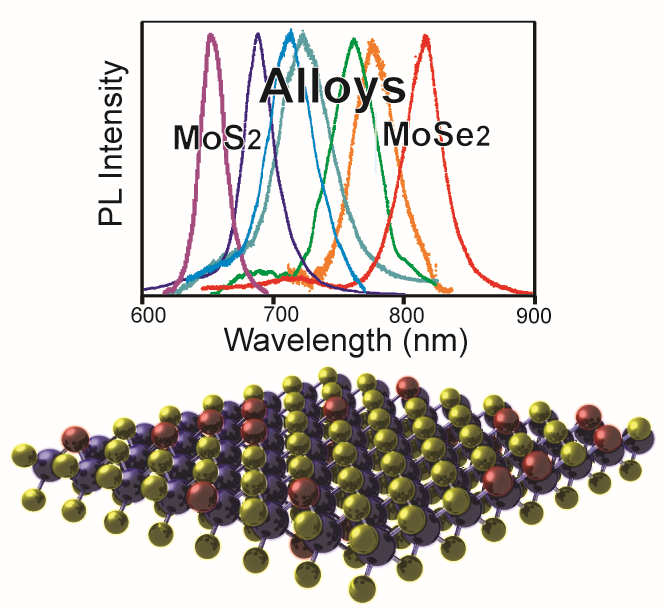2-Dimensional Transition Metal Dichalcogenides with Tunable Direct Band Gaps: MoS(2(1–x))Se(2x) Monolayers

(12/16/2014) – Single atomic layers of transition metal dichalcogenides, such as MoS2 and MoSe2, are exciting materials, because they are robust, exhibit natively semiconducting behavior and can readily be fabricated into transistors. Through the direct nature of their bandgap, these materials show promise for optoelectronic applications. In contrast to other 2D materials such as graphene and boronitride, they offer appreciable spin-orbit coupling, which leads to significant spin-splitting of their occupied electronic states (valence band), especially for MoSe2. In our research, we found that we can form single layer alloy films of MoS2 and MoSe2 at any S/Se ratio at great homogeneity (<3% compositional variation at all length scales). The bandgap of these films varies continuously with S/Se ratio between 1.87 eV (MoS2) and 1.55 eV (MoSe2) and we anticipate similar behavior of the spin splitting. This finding opens the door to bandgap engineering in transition metal dichalcogenide films. Such bandgap engineering in GaAlAs and related materials was the foundation of the development of much of today’s optoelectronic devices highlighting the importance of our finding for future TMD film applications.
These findings recently appeared in the journal Advanced Materials:
http://onlinelibrary.wiley.com/doi/10.1002/adma.201304389/abstract
Authors: John Mann 1, Quan Ma 1, Patrick M. Odenthal 1, Miguel Isarraraz 1, Duy Le 2, Edwin Preciado 1, David Barroso 1, Koichi Yamaguchi 1, Gretel von Son Palacio 1, Andrew Nguyen 1, Tai Tran 1, Michelle Wurch 1, Ariana Nguyen 1, Velveth Klee 1, Sarah Bobek 1, Dezheng Sun 1, 3, Tony. F. Heinz 3, Talat S. Rahman 2, Roland Kawakami 1, Ludwig Bartels 1
- 1. Chemistry, Physics, Electrical Engineering and Materials Science and Engineering, University of California, Riverside, CA, USA
- 2. Department of Physics, University of Central Florida, Orlando, FL, USA
- 3. Departments of Physics and Electrical Engineering, Columbia University, New York, NY, USA


